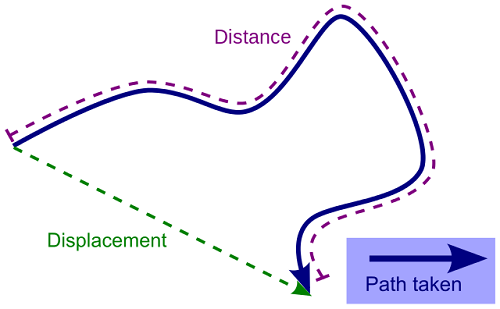In the realm of physics, the concepts of distance and displacement play crucial roles in describing the motion of objects. Both terms might seem similar at first glance, but they carry distinct meanings and are used in different contexts to analyse the movement of objects in space. Let’s delve deeper into these concepts, explore their differences, and provide illustrative examples to enhance comprehension.
1. Distance:
Distance is a scalar quantity that measures the length of the actual path traveled by an object. It is a fundamental metric used to quantify the extent of movement, regardless of direction. In simpler terms, distance only tells us how much ground an object has covered, without considering its starting or ending points or the path taken.
Example 1: Imagine a person walking in a park. If the person walks 5 kilo-meters along a winding trail, the distance covered would be 5 kilo-meters. It doesn’t matter if the person walked in a straight line or followed a zigzag path; what matters is the total length of the path traversed.
Example 2: A car travels 200 kilo-meters along a highway. Regardless of any detours or turns taken, the distance traveled by the car remains 200 kilo-meters, as it represents the total length of the route covered.

2. Displacement:
Displacement, on the other hand, is a vector quantity that measures the straight-line distance between an object’s initial and final positions, along with the direction from the starting point to the ending point. Unlike distance, displacement considers the shortest path between two points and takes into account both magnitude and direction.
Example 1: Suppose a person starts walking from point A to point B, which is 3 kilo-meters apart in a straight line. After walking 2 kilo-meters, the person changes direction and walks 1 kilo-meter backward. In this case, the displacement would be 1 kilo-meter in the direction from point B to point A, as it represents the straight-line distance between the initial and final positions.
Example 2: Consider a ship sailing from one port to another. If the ship travels 100 kilo-meters due east, then turns and sails 50 kilo-meters due north, its displacement from the starting point would be the straight-line distance from the initial position to the final position, taking into account both distance and direction.
Key Differences:
- Nature: Distance is a scalar quantity, whereas displacement is a vector quantity.
- Representation: Distance is represented by a positive value, while displacement can be positive, negative, or zero, depending on the direction of motion.
- Path Consideration: Distance accounts for the actual path traveled, while displacement focuses on the shortest path between initial and final positions.
- Direction: Displacement incorporates direction, whereas distance does not.
Conclusion:
In summary, distance and displacement are fundamental concepts in physics that help describe the motion of objects in space. While distance measures the total length of the path traveled by an object, regardless of direction, displacement represents the straight-line distance between an object’s initial and final positions, considering both magnitude and direction. Understanding the distinction between these two concepts is crucial for accurately analysing and interpreting motion in various physical scenarios.




